Two-spotted longhorn bees (Melissodes bimaculatus) love the city. This important crop pollinator is abundant in urban areas, and lucky for you, this highly distinctive bee is easy to identify. Read on to learn how to spot one in your garden (hint: look on squash and corn) and check out our field ID guide or this species profile on watchingbees.com for ID tips.
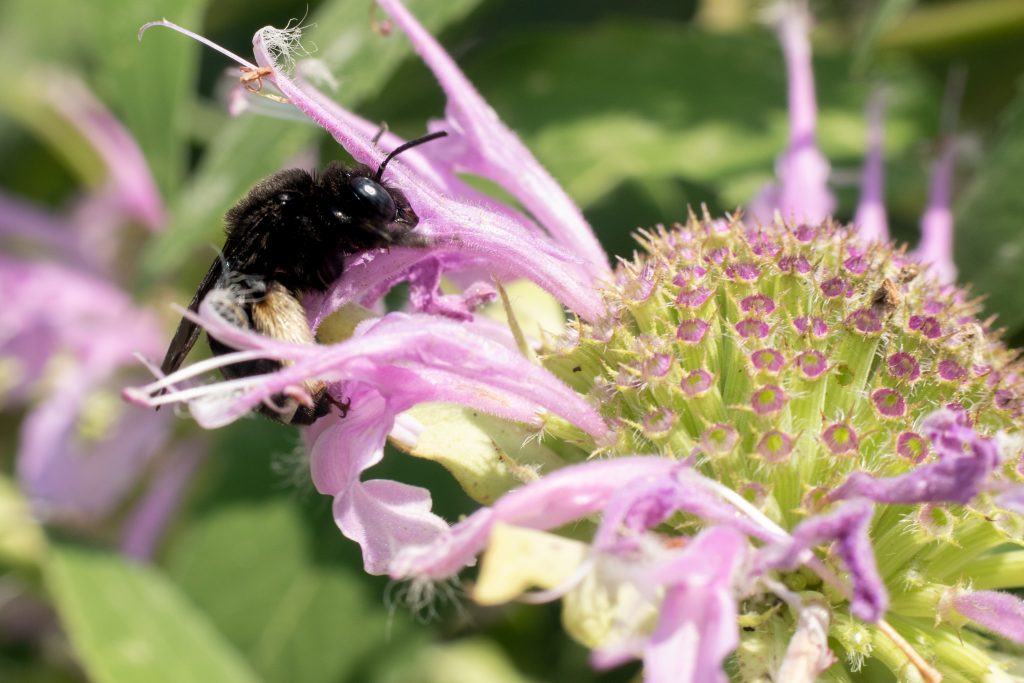
Two-spotted longhorn bee female drinking nectar from wild bergamot.
Range
Melissodes bimaculatus can be found across eastern North America, from Texas to Florida, but also as far west as the front range of Colorado. Populations occur to Minnesota and Maine.
Active Period
Two-spotted longhorn bees are active for about six weeks of the growing season—in Massachusetts, from late-June through early August—and produce one generation per year.
Appearance
Two-spotted longhorn bees are about 0.75-1x the size of a honey bee. Males are jet black, with long curly antennae, a cream-colored patch on their face, and thin white hind legs.
Female M. bimaculatus are larger and stockier than males, but with shorter antennae. They have thick brushes of white hairs on their hind legs for carrying pollen (though these hairs can be obscured by orange or yellow pollen). They also have two namesake white spots on the sides of their abdomen, though these spots are often hard to see. Females have have all black faces.
One lookalike to watch out for is the carpenter-mimic leaf-cutter bee (Megachile xylocopoides). This species is found only as far north as southern New Jersey. Females of this species carry pollen beneath their abdomens, not on their legs, and both sexes often hold their wings out at a 45˚ angle while foraging.
Male Behavior
In late-June, males emerge from the ground and patrol patches of flowers in search of females. Male M. bimaculatus are zippy; they speed through the garden, only stopping briefly to sip nectar or rest on a leaf. At night, males sleep on vegetation. They bite twigs or long blades of grass, often two to three feet off the ground, and hang on all night long with their mandibles. Males are highly faithful to particular sleeping perches, and will often sleep near other males. Maybe your garden is home to one of their adorable slumber parties!
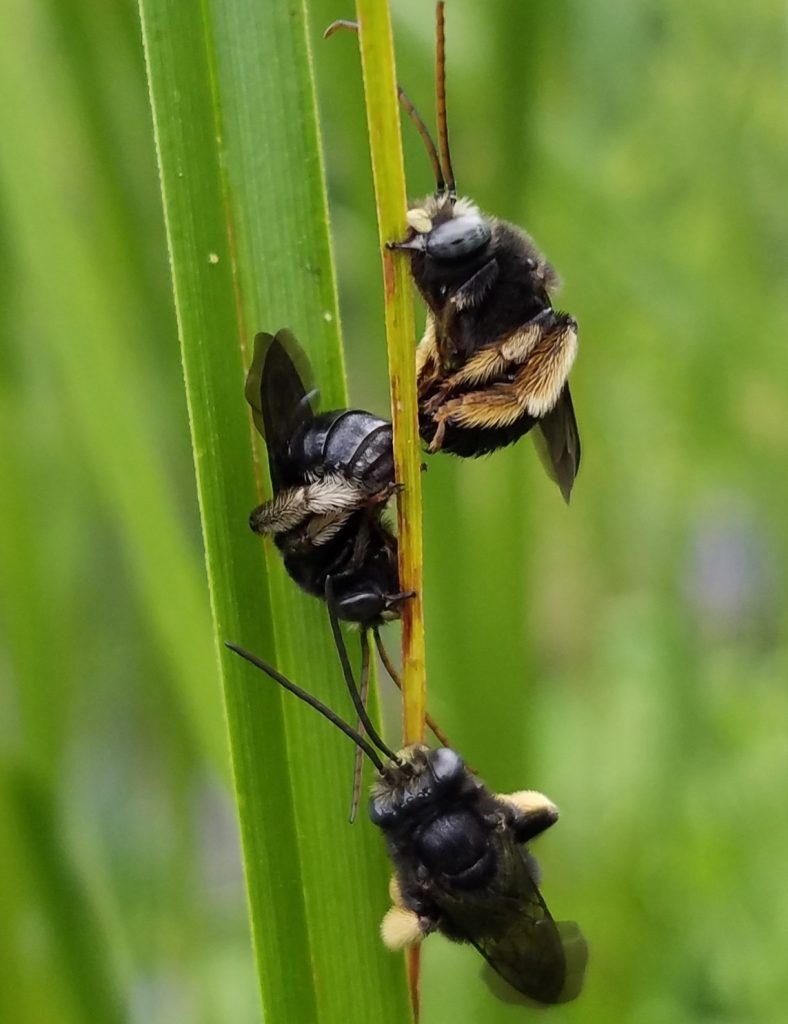
Shhh! The bees are sleeping. Male M. bimaculatus sleep next to each other on vegetation at night! PC: pawelp, iNaturalist
Female Behavior
Females emerge shortly after males and get to work collecting pollen and nectar provisions for their solitary underground nests. Despite their abundance, two-spotted longhorn bees nest in obscurity; few nests have ever been documented. We suspect they nest in sparsely vegetated soils, such as those found on the margin of a garden bed. If you think you’ve found a nest, please reach out!
Floral preferences
The best way to spot M. bimaculatus is to spend time watching your garden in mid summer. Male and females drink nectar from a variety of common vegetable garden plants, including cucumbers, squash, black-eyed susans, oregano, cosmos, purple coneflowers, and zinnias. Females specially like visiting tubular flowers such as wild bergamot (Monarda fistulosa), hoary vervain (Verbena stricta), and mountain mint (Pycnanthemum).
Females collect pollen from a staggering array of plants, including asters like black-eyed susans (Rudbeckia) and cosmos, pumpkins and zucchini (Cucurbita pepo), moss rose (Portulaca grandiflora), rose of sharon (Hibiscus syriaca), and morning glories (Ipomaea purpurea).
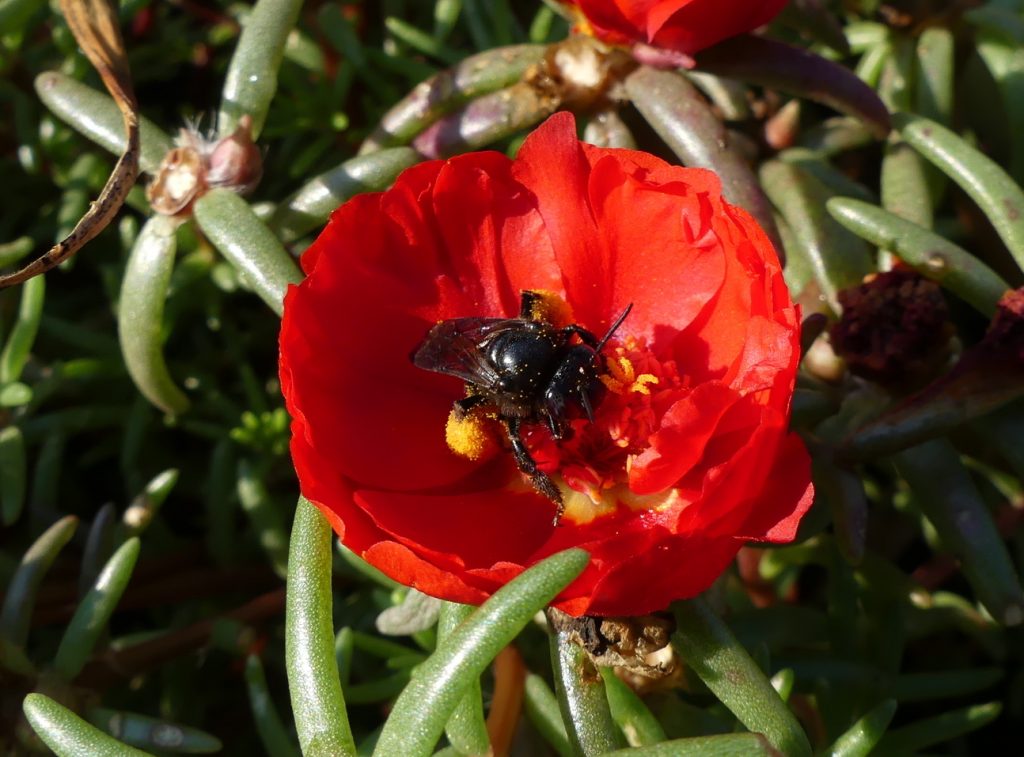
M. bimaculatus female collecting pollen from portulaca. Notice the huge bundles of orange pollen on her hind legs. PC: botanygirl, iNaturalist
In addition, while studying M. bimaculatus movement in urban gardens last year, TPI scientists noticed that this species has a curiously strong affinity for corn pollen (Zea mays). This was unexpected since corn flowers have evolved to disperse pollen on the wind, not via insects*. Corn pollen is dry and light, and the flowers produce no nectar, so we figured that M. bimaculatus must have been seeking out corn flowers for pollen. Upon a closer look, we saw a female actively packing corn pollen into her scopae, i.e. the thick hairs on her hind legs. We followed up on our observations by visiting local farms in the area growing corn. Sure enough, M. bimaculatus was on corn flowers in every single field.
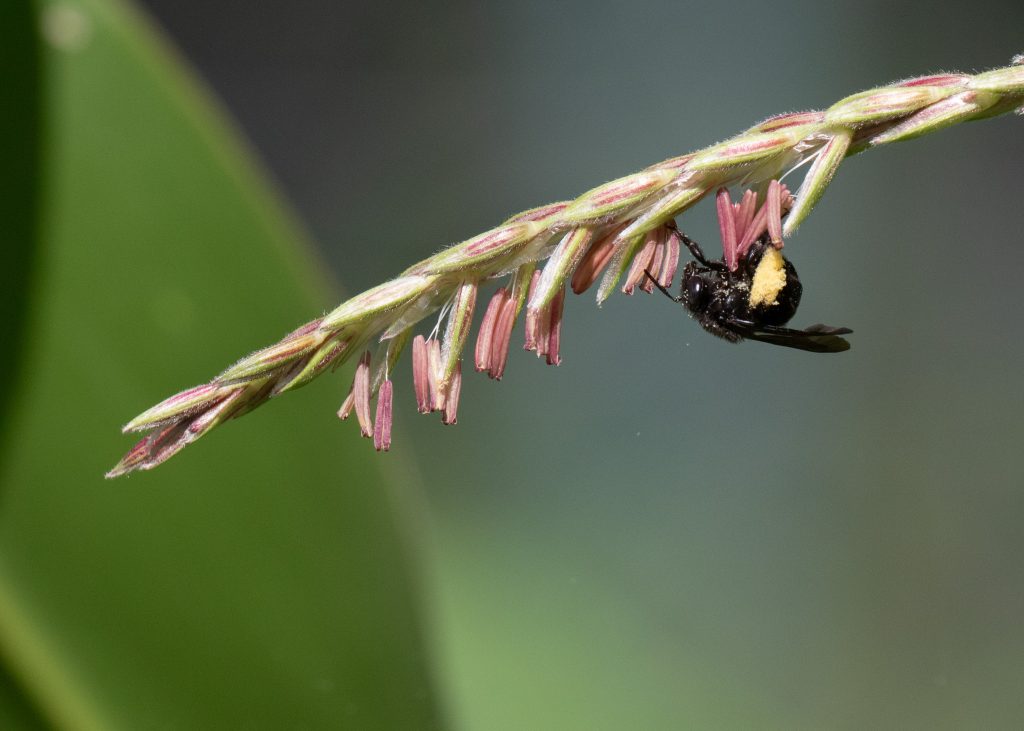
Female M. bimaculatus collecting corn pollen in an urban vegetable garden in Massachusetts.
This remarkable association between M. bimaculatus and corn raises many more questions than it answers. Corn is not native to eastern North America—though it has been grown here for thousands of years by native peoples—so which came first? Did M. bimaculatus arrive in this region following widespread trade of corn? Or did M. bimaculatus evolve a local preference for corn pollen since few other flower-visiting insects use this resource? Regardless, we encourage you to look for M. bimaculatus on corn flowers in your garden this year.
Share your findings on iNaturalist or comment on this post! Happy bee watching.
*By collecting pollen from tall male corn flowers, M. bimaculatus is a pollen thief, not a pollinator. M. bimaculatus is not a corn pollinator since it never visits the female flowers of corn plant (the silky ears lower down on the plant), which produce no pollen and offer no nectar.
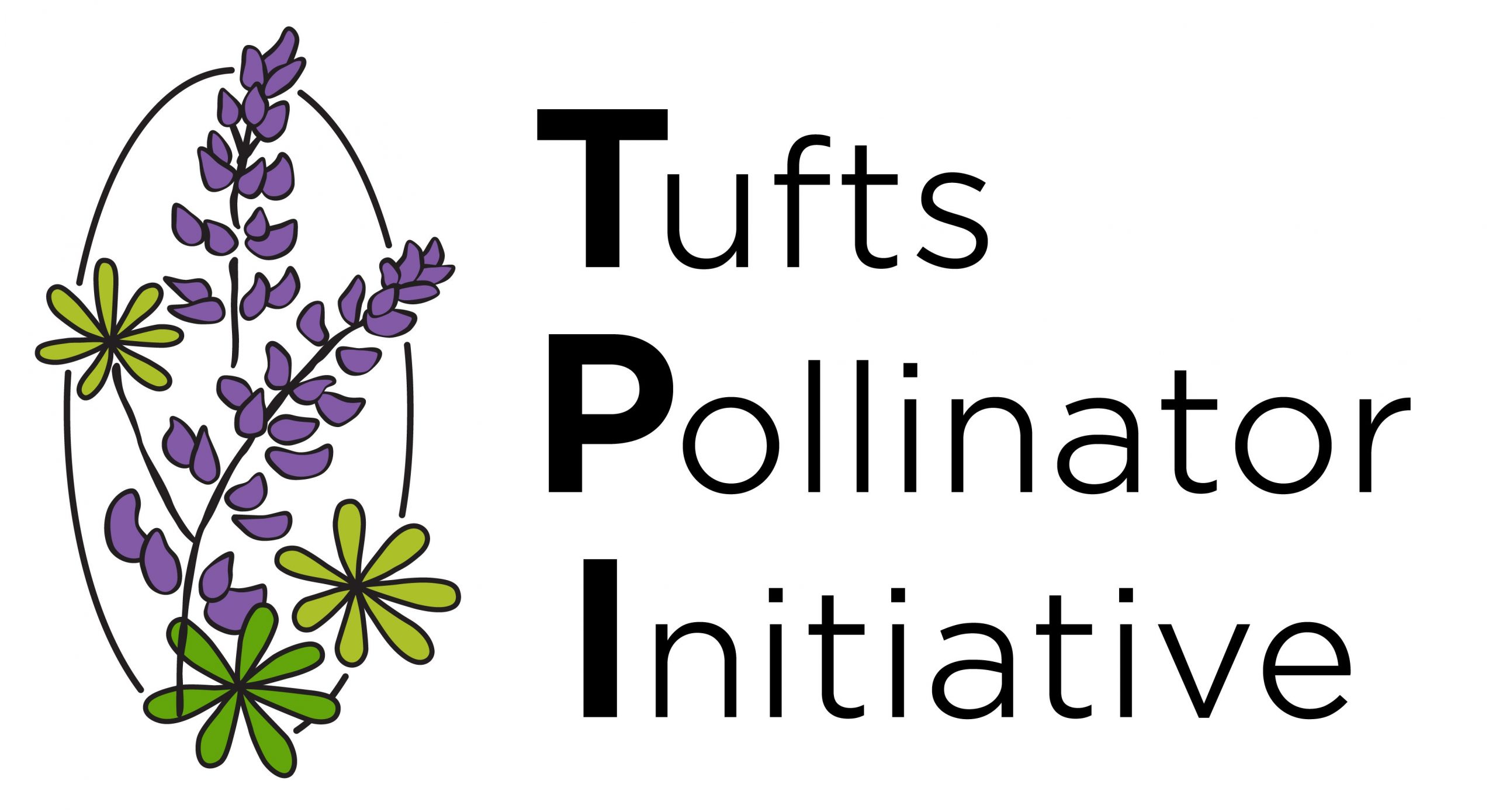

I found a number of these bees resting on flower stalks of Columbine in my flower garden. Just over the fence is the vegetable garden with squash, zucchini, tomatoes, peppers, strawberries and large grape vines. These bees were quite evident on the now-drying flower stems of the Columbines, and marks seemed to indicate that they rested there often, gripping with their mandibles and leaving tiny indentations in the stalk. They did not seem aggressive at all, and were hard to disturb (awaken?). I live on the Front Range of Colorado, so consider that their range comes at least this far west. I have a number of photos of them all together on several flower stems.
Thank you for this comment! We have updated the range of this bee to include your observations (they do seem to be present in Colorado from other range maps too).
It seems you have stumbled upon a slumber party of longhorn bees! The bees on the stalks are most likely males with long antennae and cream-colored spots on their face. Great job noticing these native bees!
Thank you for all of this information. I saw one today on my cosmos in Lima, NY and took a picture to google lens it because I have never seen one before. Your information was helpful.
We are glad this information helped you in your observations of wild pollinators!
I’ve seen this species visit Tripsacum dactyloides which is a distant relative of corn here in South East Texas. They seemed to be very invested in the activity.
Wow, very intriguing observation. Thank you for sharing!
Found a slumber party on my asters just now!
Awesome !! Aren’t the males the cutest ? Does the slumber party happen night after night ?
Today is the first time I’ve seen a all black bee before, so I took a picture and used Google lens and learned about the long horn two spotted bee. Learned it was a female, because of the tufts of hair on her legs for collecting pollen, on some zinnias here in central Louisiana.
Yes, I often find females on zinnias too!
I have a nesting group in the cracks of sidewalk block near back door in Bismarck,
ND . So far only seen this once and they are quite shy when I am near. Will try to get photos and video of activity. Will post on iNaturalist.
The males roost on ornamental grasses nearby.
They are feeding on cosmos, moss roses, upright prairie coneflower in my garden.
Thanks for the observation! Sounds like the right species to me!
Nicholas
Counted 8 entrance holes between concrete sidewalk blocks with curled up garden hose somewhat protecting. Noticed about 5 are active. See 2 iNaturalist posts of 7-15 12:13pm and 3:09 pm and one from 7-21-2023 9:20am for pictures @daleheinert . Are feeding on Russian Sage, Catmint, Narrow-leafed Purple Coneflower.
Also saw Leafcutter Bee using hole in lawn which was quite surprising. See iNatualist 7-16-23 post. Noticed more than once using this entrance hole but only got pictures once.
Dale
Found a large “flock” of these guys in the vegetation that hides my power box in eastern Nebraska
Rockwall, Tx
This is my 2nd year with a vegetable garden in my yard. I didn’t see any last year and my crop was mediocre. This year I see these daily on my cucumber vines, they seem to love the blossoms and I have an avalanche of cucumbers!
Thank you for helping me identify these pollinators!
So glad for you!
We discovered a dozen or so on our wild grasses. Larches, many grass varieties, coneflowers, lilies, Black-Eyed Susans, etc nearby. -Justin, Washington, IL
Amazing! Aren’t they so fun to watch?
We found a bee slumber party on our grasses this evening! Thought they were Japanese beetles clustered together at first, but upon a closer look, we realized they were bees. Didn’t know what kind they were so thanks to Google lens, it popped up with the picture of these two-spotted longhorns. Came across your website thankfully, which provided a lot of great information about these little guys, including the picture you have above, which is almost identical to the picture I took of the bees at our place. So cool!!
Thanks for sharing your observation!